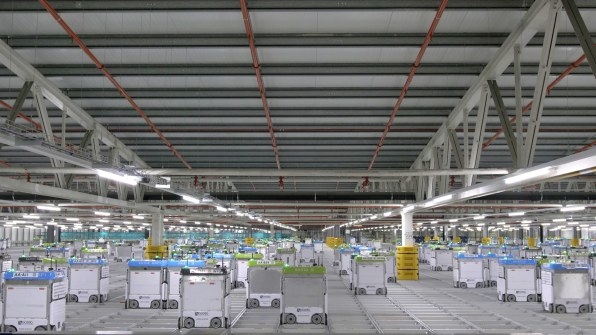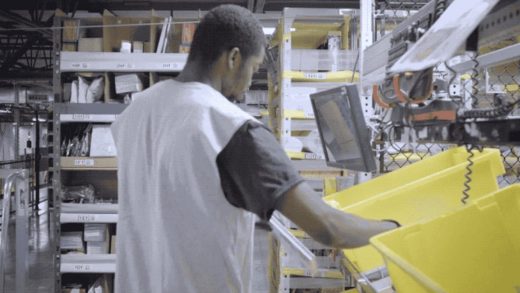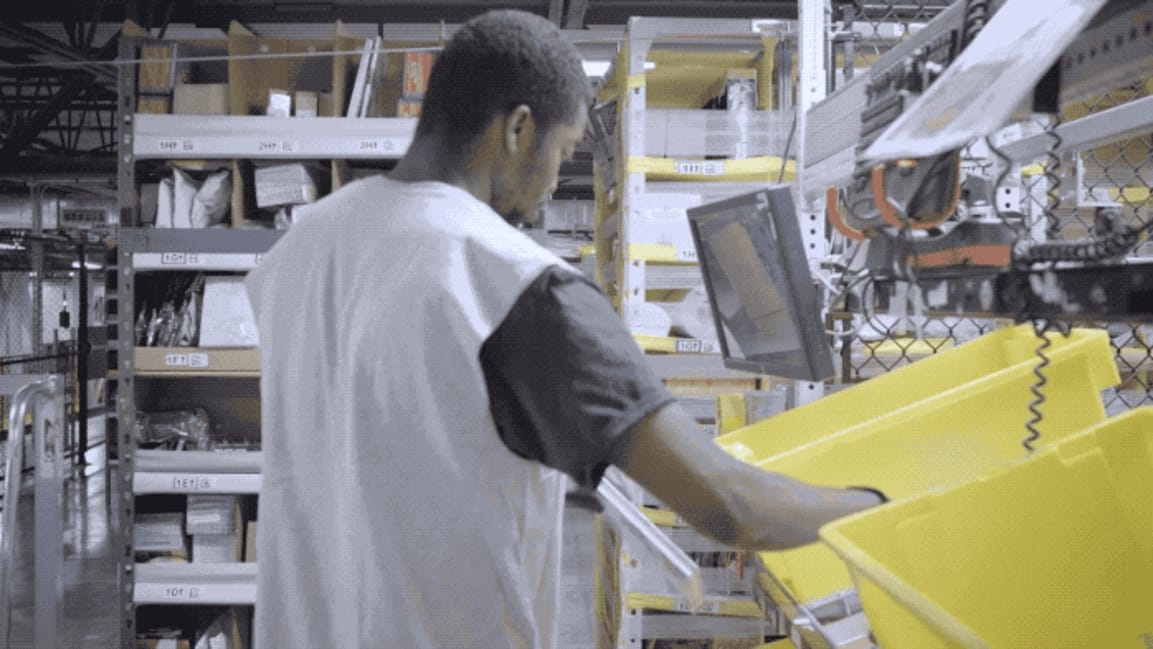Amazon and Walmart add more robots, but insist they won’t terminate jobs
Since Amazon bought warehouse robotics company Kiva Systems in 2012, its efforts in automation have been well known. The retail and tech powerhouse has introduced its cashierless Amazon Go stores, flirted with plans for drone deliveries, and rolled out tens of thousands of robots to shuffle goods around its fulfillment centers.
“In fulfillment centers that have drive units, we’re able to store up to 40% more inventory and move customer orders in a faster, more efficient way,” wrote VP of robotics Brad Porter in an email to Fast Company, referring to the Kiva-derived warehouse transport bots. “As a result, we can make faster deliveries, offer lower prices, and ultimately, deliver a better customer experience.”
But Amazon hasn’t been alone in pushing to bring robotics to the world of retail. Archrival Walmart has been adding bots to many of its warehouses and stores. A grocery distribution center in Shafter, California, is set to open in 2020, with new technology in place to shuttle even perishable goods around the warehouse without damaging them. In a Salem, New Hampshire, Walmart, automated carts will soon shuttle components of online grocery orders from an attached warehouse to be packaged up by human workers.
Other store bots include an autonomous scrubber that’s set to clean floors in 360 Walmart stores by the end of January, a robotic truck-unloading system that can sort and triage new deliveries on their way to shelves, and even machines that roll through store aisles to track inventory and spot misshelved goods.
“This robot can do in about two-and-a-half hours what it was taking an associate around two weeks to do, which is go through all of a department and scan the merchandise and determine where are the [out of stock items], where do we need to get the merchandise, the out of stock levels, those type of things,” says Walmart spokesperson Ragan Dickens.
Automated pickup towers in many stores also deliver customers their online orders without them having to wait on a store employee.
Separately, supermarket chain Kroger last month announced plans with a U.K. online retailer to build “an automated warehouse facility with digital and robotic capabilities” outside of Cincinnati, and Bossa Nova, the San Francisco company that’s brought shelf-scanning bots to dozens of Walmart stores, is working with at least five other as-yet-unnamed retailers on similar projects, says chief business officer Martin Hitch.
“This is the most exciting time in retail in roughly the past 100 years,” says Sterling Hawkins, head of operations and venture relations for the Center for Advancing Retail & Technology, which connects retailers and tech vendors. “Finally, this emerging technology–automation, AI, robotics–is at a point where it can actually deliver on the vision technically and economically.”
Will jobs be destroyed or created?
Stores say automation can help them get goods to customers more efficiently. Those Amazon robots mean warehouses can store more goods and enable the fast deliveries that the company’s become known for, according to the company. Similarly, Walmart says its robots mean fewer customers will be unable to buy their favorite products because they’re sitting on the loading dock instead of on the shelf where they belong.
But some critics fear robots will inevitably also take jobs away from retail, warehouse, and maintenance workers.
“Make no mistake, Walmart’s move to autonomous floor cleaners is not about better serving customers and workers,” warned the United Food and Commercial Workers International Union’s Making Change at Walmart project in a statement last week. “This latest job-killing venture has the potential to destroy over 5,000 maintenance jobs in the U.S. if it is implemented in every Walmart store.”
The union, which based that number on an assumption that the devices would ultimately mean one less maintenance position per store, has had similar criticism for Amazon’s push to automation.
“Amazon is clearly determined to profit by creating a future where automation replaces good jobs,” UFCW President Marc Perrone said in an open letter to Whole Foods Market CEO John Mackey last year, as that supermarket chain was being acquired by Amazon.
More recently, he’s expressed concern about a Wall Street Journal report that Amazon is testing its cashier-free systems for larger stores, potentially including Whole Foods locations.
Amazon declined to comment to Fast Company about that report, but in general the company has said automation has helped it create jobs, not replace human workers.
“We are both creating jobs and adding automation,” Porter wrote, saying the company has added more than 300,000 full-time workers since 2012. “Automation has allowed us to offer increasing selection with faster delivery at lower cost. This is a virtuous cycle allowing our business to continue to grow and create more jobs.”
Walmart’s Dickens, too, says the chain’s robots are allowing employees to focus on tasks machines can’t do, like cleaning areas where robots can’t reach or restocking shelves that a robot has pointed out are running low. And, he emphasizes, newly automated tasks like scrubbing floors, checking out online orders, or checking shelves for products in need of replacement aren’t the entirety of anyone’s shift.
“These are portions of a larger role that the associate is playing,” he says.
In some cases, they’re also automating away the more unpleasant parts of tasks like unloading trucks in the back of a store, potentially improving the job and reducing turnover. They also let staff spend more time directly helping customers, he says.
“While yes, there’s robotics in the store, it’s assisting the associate with their job rather than replacing it,” he says. “What we’re working on is providing our associates good jobs and providing out customers good experiences.”
Smooth operator! ????
Our #robots boast built-in, redundant safety sensing so as to never collide with people, mobile, or fixed obstacles. #TechTuesday #RetailAutomation #CustomerExperience pic.twitter.com/GnoNeMPri8
— Bossa Nova (@bossanova) November 13, 2018
“The store is changing”
Walmart typically employs about 300 people in its “Supercenter” stores and about 90 in its smaller “Neighborhood Market” locations. A 2015 Reuters report found the stores employed fewer people per square foot that year than 10 years ago, with store space per employee rising to 547 square feet from 407 square feet in 2005. At the time, Walmart attributed the change to efficiency improvements, including “shelf-ready packaging,” motorized devices to transport shopping carts, and the rise of self-checkout.
Dickens declined to speculate on what employment numbers might look like in the future, saying stores will continue to evolve to meet changing customer needs.
“The store is changing,” he says. “It’s different today than it was 10 years ago, and I imagine in 10 years it will look a little differently than it does today.”
That new technology will let workers spend more time working with the public instead of putting them out of a job is a common refrain, heard from police departments installing crime cameras and airlines shifting to biometric check-in as well as retailers. It may sound hard to believe, but it has happened in other industries: As bank customers moved many transactions from the teller desk to ATMs, bank employment actually went up, since banks could afford to open more branches with fewer tellers each, says Jim Bessen, executive director of the Technology & Policy Research Initiative at Boston University.
“The nature of the job changed so it was much more of a marketing job,” he says. “They would play a more crucial role in helping sell products that the bank offers to customers that are higher margin than cash handling.”
So far, the shift to e-commerce has created more jobs than it’s taken away, and fulfillment center jobs often pay better than traditional retail hours, says Michael Mandel, the chief economic strategist at the Progressive Policy Institute. “We estimate that e-commerce jobs in fulfillment centers and
e-commerce companies rose by 400,000 from December 2007 to June 2017, substantially exceeding the 140,000 decline of brick-and-mortar retail jobs,” he writes in a paper published last year.
“Historically, we’ve seen that increases in productivity are very often linked to increases in employment because you can do things you couldn’t do before,” he says. “In this case it’s been super clear that people are now using online [shopping] to buy all sorts of things like kitty litter rather than going to the store.”
Mandel says he’s optimistic that automation will lead to job creation, even if retailers continue to automate. If the retail sector ultimately cuts jobs because it’s cheaper to replace humans with robots, it’s likely that will mean cheaper distribution costs for manufacturers, which could spell new business models popping up and product makers employing humans in new roles.

[Photo: courtesy of Kroger]
Rocky transition for longtime retail workers
To Stacy Mitchell, co-director of the Institute for Local Self-Reliance and a longtime critic of Amazon and big box chain stores, the concern isn’t so much the rise of automation but the fact that community businesses, small manufacturers, and entrepreneurs pursuing a better life can’t thrive amid price pressure from the retail giants.
“I don’t think we should want to hang on to these terrible warehouse jobs,” says Mitchell. “What I am concerned about is the effect that consolidation is having on new business formation.”
Even if automation does create new jobs, it could be a rocky transition for some longtime retail workers. An influential report on workplace automation released by McKinsey last December warned that while technological changes often do create more jobs than they erase, it will be essential to ensure people have access to training to let them quickly move into those new occupations.
“Increased investment and productivity growth from automation could spur enough growth to ensure full employment, but only if most displaced workers find new work within one year,” according to the report. “If reemployment is slow, frictional unemployment will likely rise in the short-term and wages could face downward pressure.”
About 3.4 million people currently work as retail cashiers, according to Bureau of Labor Statistics estimates, and UFCW communications director Erikka Knuti argues it’s unclear what sorts of work they’d switch to in a world of largely automated commerce.
“Those are good jobs that can provide a person with a living and a way to provide a better living for their family,” she says. “They’re not going to all go to Silicon Valley and start coding, and not everybody can do warehouse work.”
Fast Company , Read Full Story
(16)



